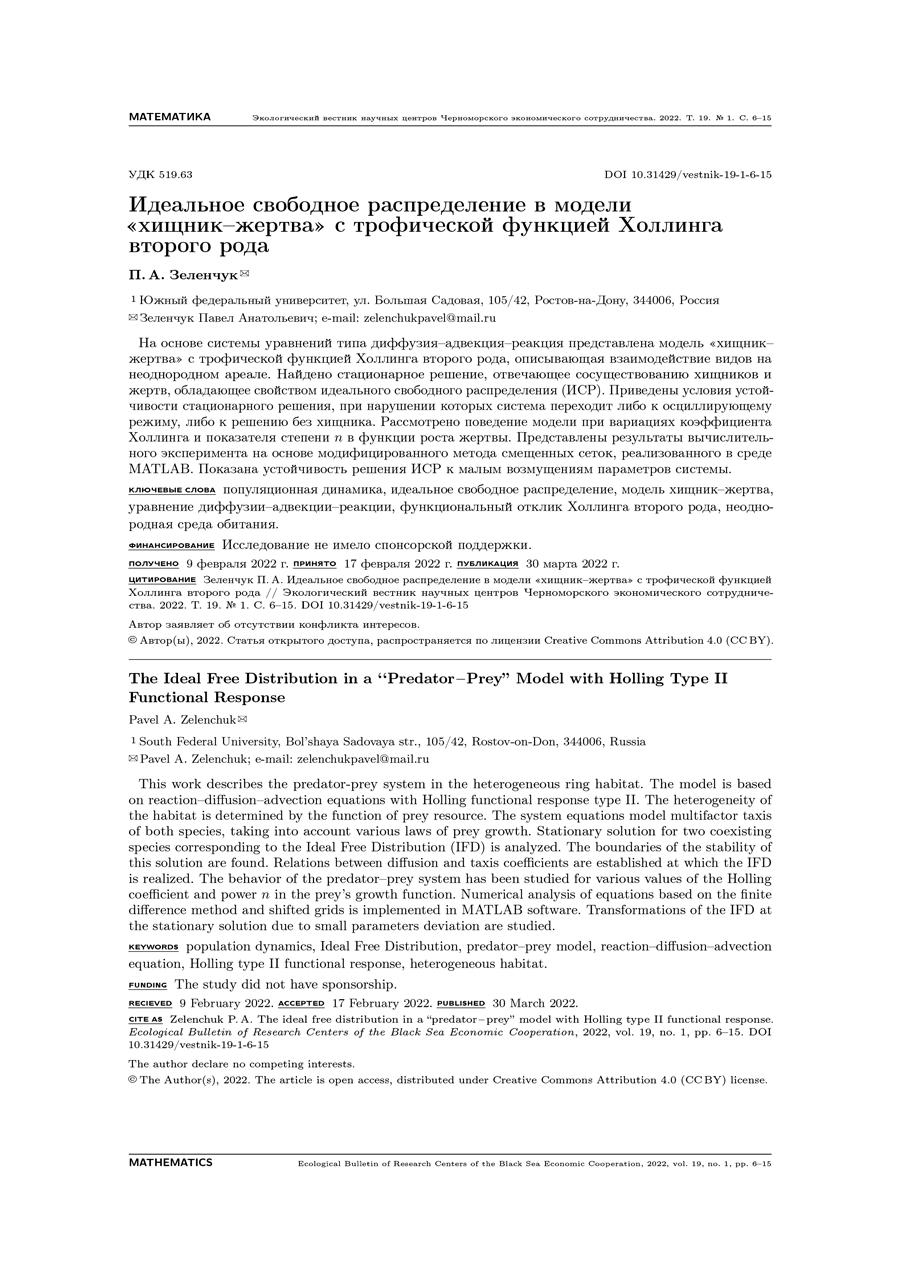The ideal free distribution in a "predator-prey" model with Holling type II functional response
UDC
519.63DOI:
https://doi.org/10.31429/vestnik-19-1-6-15Abstract
This work describes the predator-prey system in the heterogeneous ring habitat. The model is based on reaction-diffusion-advection equations with Holling functional response type II. The heterogeneity of the habitat is determined by the function of prey resource. The system equations model multifactor taxis of both species, taking into account various laws of prey growth. Stationary solution for two coexisting species corresponding to the Ideal Free Distribution (IFD) is analyzed. The boundaries of the stability of this solution are found. Relations between diffusion and taxis coefficients are established at which the IFD is realized. The behavior of the predator-prey system has been studied for various values of the Holling coefficient and power n in the prey’s growth function. Numerical analysis of equations based on the finite difference method and shifted grids is implemented in MATLAB software. Transformations of the IFD at the stationary solution due to small parameters deviation are studied.
Keywords:
population dynamics, Ideal Free Distribution, predator-prey model, reaction-diffusion-advection equation, Holling type II functional response, heterogeneous habitatReferences
- Ризниченко Г.Ю. Математическое моделирование биологических процессов. Модели в биофизике и экологии, Юрайт, Москва, 2020. [Riznichenko G.Y. Matematicheskoe modelirovanie biologicheskikh protsessov. Modeli v biofizike i ekologii = Mathematical modeling of biological processes. Models in biophysics and ecology, Yurayt, Moscow, 2020. (in Russian)]
- Безуглова О.С., Назаренко О.Г., Ильинская И.Н. Динамика деградации земель в Ростовской области. Аридные экосистемы, 2020, т. 26, № 2(83), с. 10–15. [Bezuglova O.S., Nazarenko O.G., Iljinskaya I.N. Land degradation dynamics in Rostov oblast. Arid Ecosystems, 2020, vol. 10, no. 2, pp. 93–97. (in Russian)] DOI 10.1134/S207909612002002X
- Литвинская С.А. Состояние популяций редких видов азовской прибрежной зоны. В: Биологическое разнообразие Кавказа и Юга России: Мат. XXI Междунар. науч. конф., Изд-во ООО «КЕП», 2020, с. 184–186. [Litvinskaya S.A. State of populations of rare species of the Azov coastal zone. In: Biologicheskoye raznoobraziye Kavkaza i Yuga Rossii: Materialy XXI Mezhdunarodnoy nauchnoy konferentsii = Biological diversity of the Caucasus and the South of Russia: Abstr. of the XV International conf., OOO "KEP" Publ., 2020, pp. 184–186. (in Russian)]
- Cruz C., Santulli–Sanzo G., Ceballos G. Global patterns of raptor distribution and protected areas optimal selection to reduce the extinction crises. Proc. of the National Academy of Sciences of the USA, 2021, vol. 118, iss. 37, pp. 1–8.
- Murray J.D. Mathematical biology. II: Spatial models and biomedical applications. Springer, New York, NY, 2003. 814 p.
- Cosner C. Reaction-diffusion-advection models for the effects and evolution of dispersal. Discrete and Continuous Dynamical Systems, 2014, vol. 34, iss. 5, pp. 1701–1745.
- Будянский А.В., Цибулин В.Г. Моделирование многофакторного таксиса в системе "хищник–жертва". Биофизика, 2019, т. 64, № 2, с. 343–349. [Budyansky A.V., Tsybulin V.G. Modeling of multifactor taxis in a predator–prey system. Biophysics, 2019, vol. 64, no. 2, pp. 256–260. (in Russian)] DOI 10.1134/S0006350919020040
- Cantrell R.S., Cosner C., Deangelis D.L., Padron V. The ideal free distribution as an evolutionarily stable strategy. Journal of Biological Dynamics, 2007, vol. 1, no. 3, pp. 249–271.
- Cressman R., Garay G., Křivan V. Ideal free distributions, evolutionary games, and population dynamics in multiple–species environments. American Naturalist, 2004, vol. 164, no. 4, pp. 473–489.
- Cantrell R.S., Cosner C., Martinez S., Torres N. On a competitive system with ideal free dispersal. Journal of Differential Equations, 2018, vol. 265, no. 8, pp. 3464–3493.
- Зеленчук П.А., Цибулин В.Г. Идеальное свободное распределение в модели «хищник-жертва» при многофакторном таксисе. Биофизика, 2021, т. 66. № 3, с. 546–554. [Zelenchuk P.A., Tsybulin V.G. The ideal free distribution in a Predator-Prey model with multifactor taxis. Biophysics, 2021, vol. 66, no. 3, pp. 464–467. (in Russian)] DOI 10.1134/S0006350921030246
- Цибулин В.Г., Ха Т.Д., Зеленчук П.А. Нелинейная динамика системы хищник–жертва на неоднородном ареале и сценарии локального взаимодействия видов. Известия высших учебных заведений. Прикладная нелинейная динамика, 2021, т. 29, № 5, с. 751–764. [Tsybulin V.G., Ha T.D., Zelenchuk P.A. Nonlinear dynamics of the Predator–Prey system in a heterogeneous habitat and scenarios of local interaction of species. Izvestiya Vysshikh Uchebnykh Zavedeniy. Prikladnaya Nelineynaya Dinamika = News of Higher Educational Institutions. Applied Nonlinear Dynamics, 2021, vol. 29, no. 5, pp. 751–764. (in Russian)]
- Тютюнов Ю.В., Титова Л.И. От Лотки–Вольтерра к Ардити–Гинзбургу: 90 лет эволюции трофических функций. Журнал общей биологии, 2018, т. 79, № 6, с. 428–448. [Tyutyunov Yu.V., Titova L.I. From Lotka–Volterra to Arditi–Ginzburg: 90 years of evolving throphic functions. Zhurnal Obshchey Biologii = Journal of General Biology, 2018, vol. 79, no. 6, pp. 428–448. (in Russian)] DOI 10.1134/S004445961806009X
- Базыкин А.Д. Математическая биофизика взаимодействующих популяций, Москва, Наука, 1985. [Bazykin A.D. Matematicheskaya biofizika vzaimodeystvuyushchikh populyatsiy = Mathematical biophysics of interacting populations, Moscow, Nauka, 1985. (in Russian)]
- Будянский А.В. Влияние направленной миграции на заполняемость ареала в системе «хищник–жертва». Экологический вестник научных центров Черноморского экономического сотрудничества, 2020, т. 17, № 3, с. 6–12. [Budyansky A.V. Influence of directed migration on the occupancy of the area in the "predator–prey" system. Ekologicheskiy vestnik nauchnykh tsentrov Chernomorskogo ekonomicheskogo sotrudnichestva = Ecological Bulletin of Research Centers of the Black Sea Economic Cooperation, 2020, vol. 17, no. 3, pp. 6–12. (in Russian)] DOI 10.31429/vestnik-17-3-6-12
Downloads
Submitted
Published
How to Cite
Copyright (c) 2022 Zelenchuk P.A.

This work is licensed under a Creative Commons Attribution 4.0 International License.




